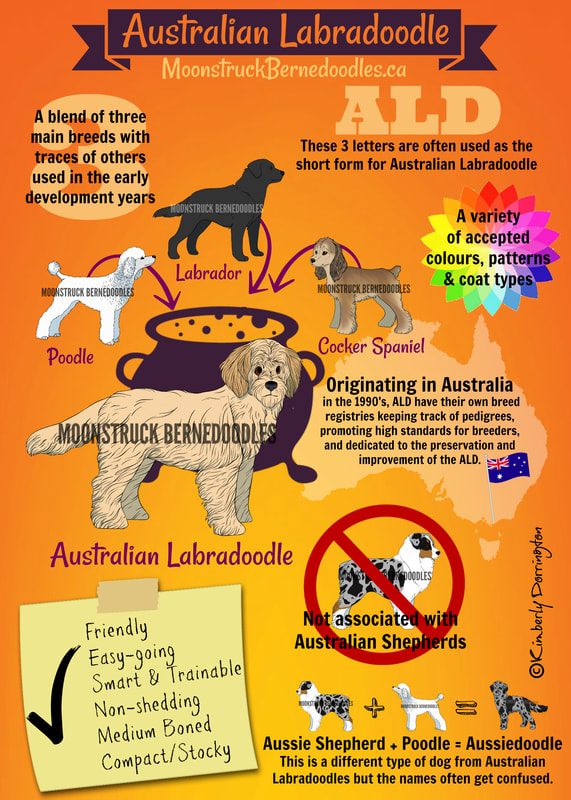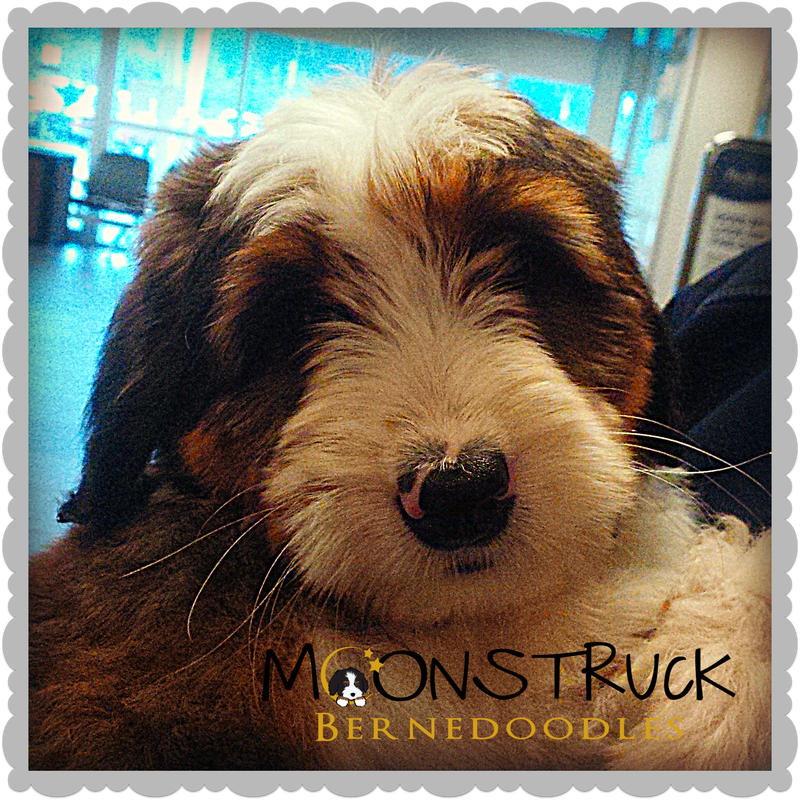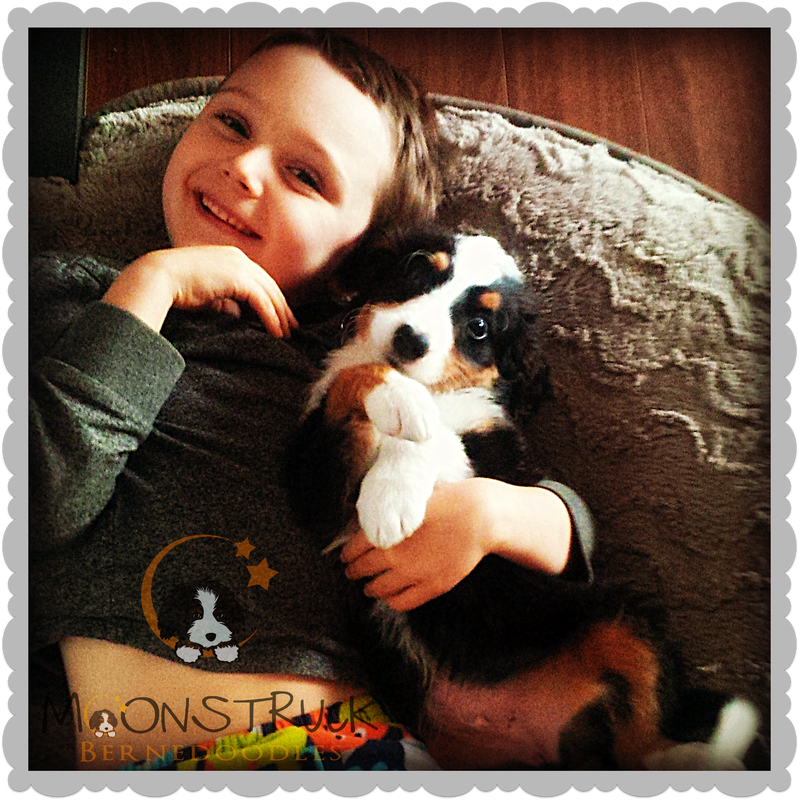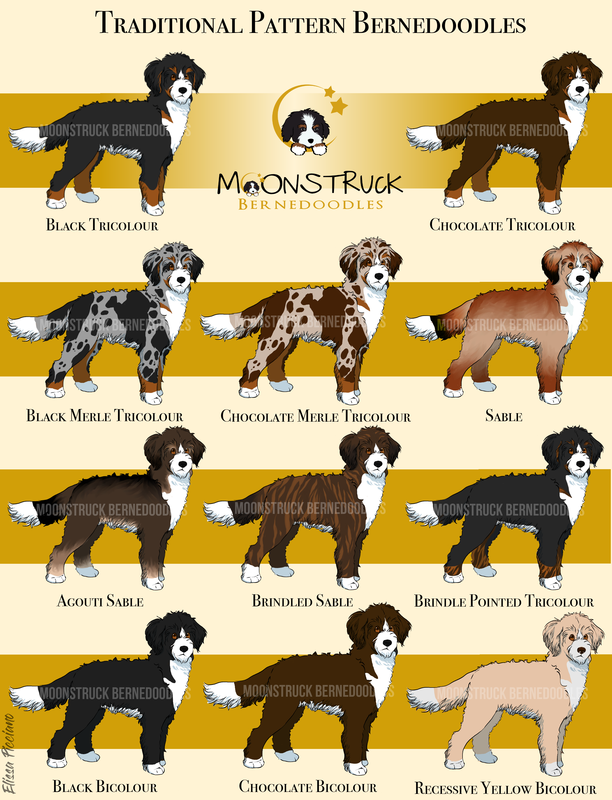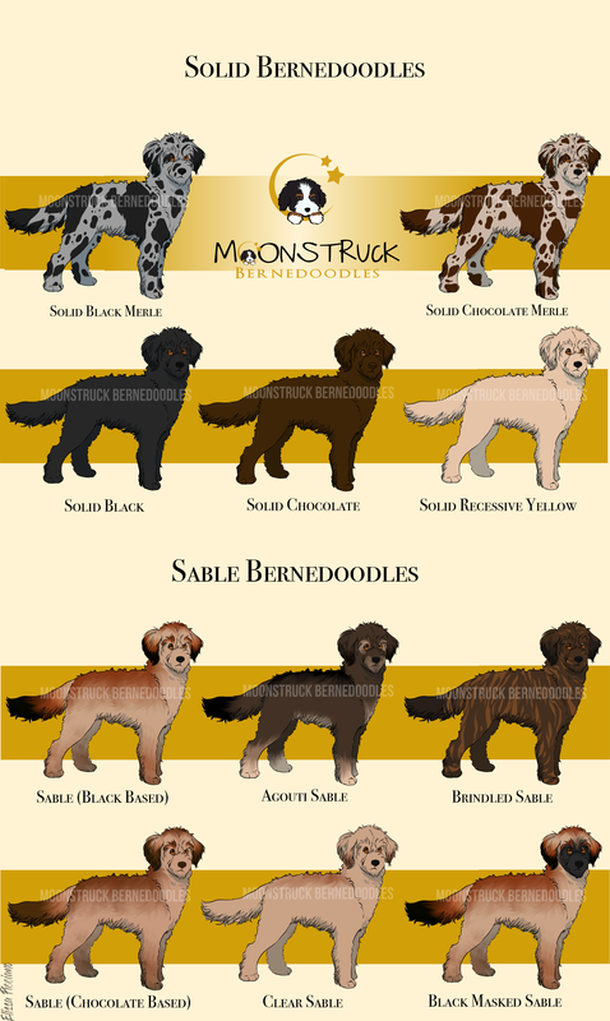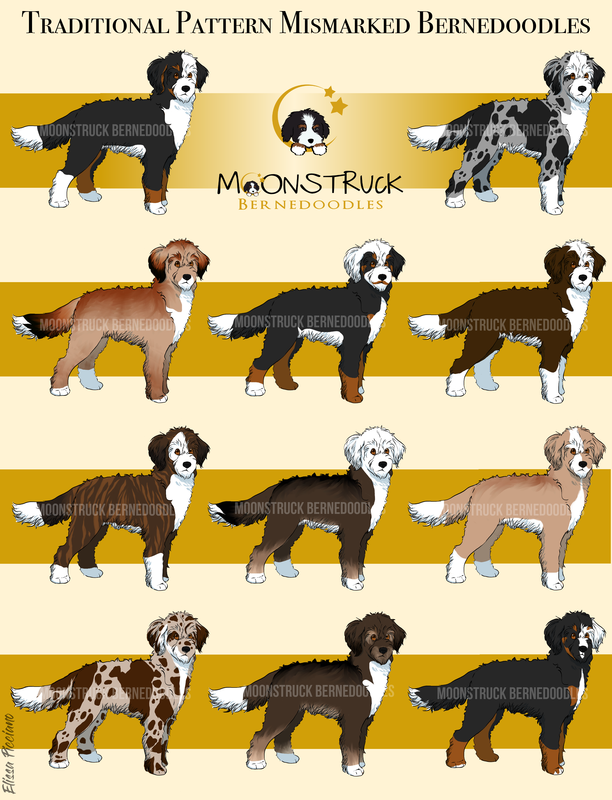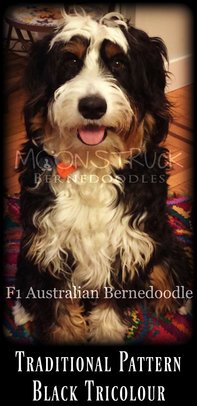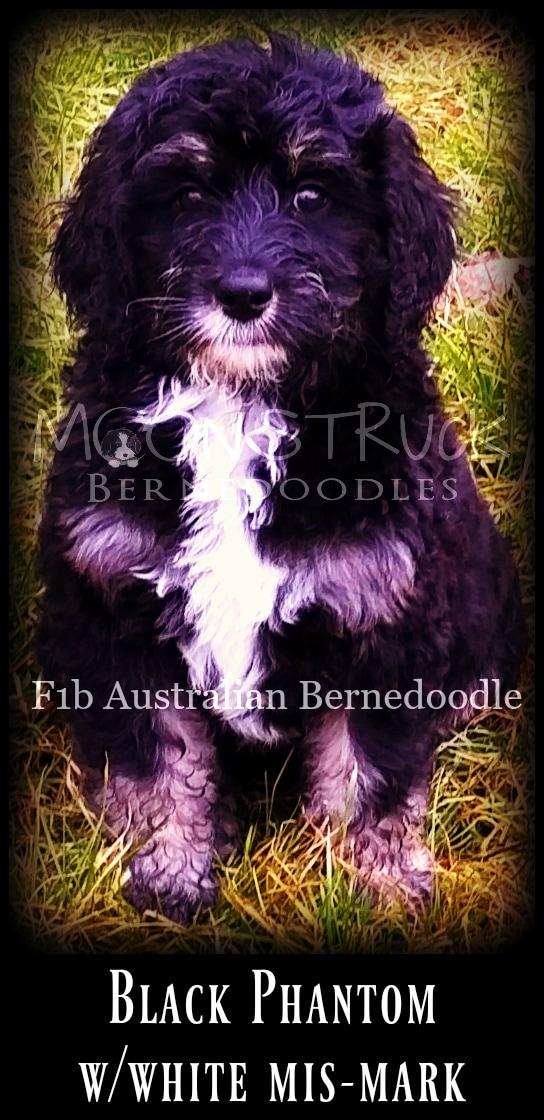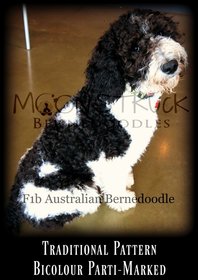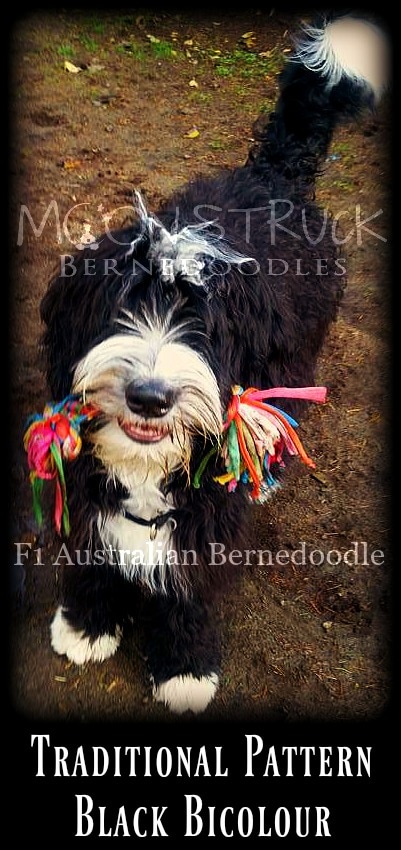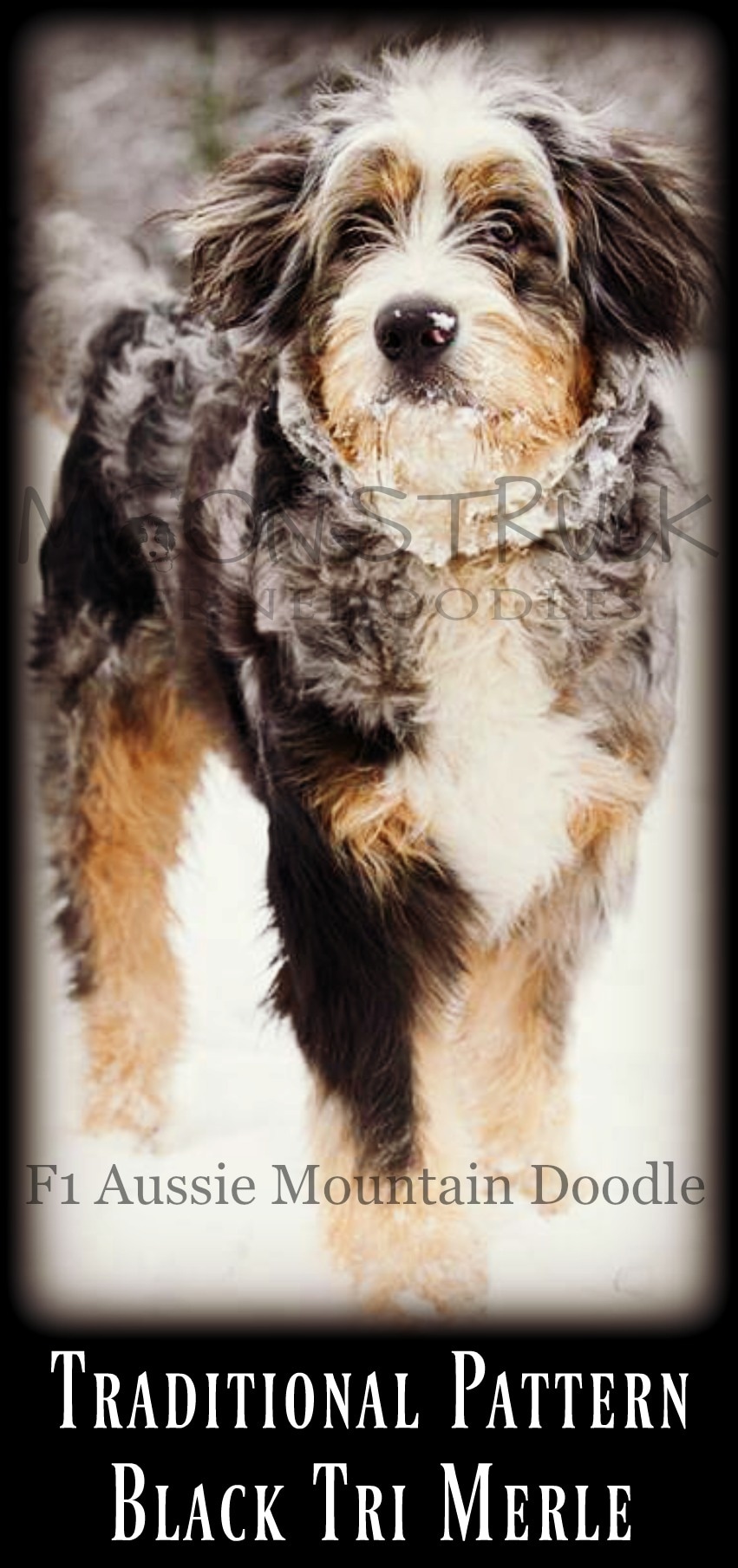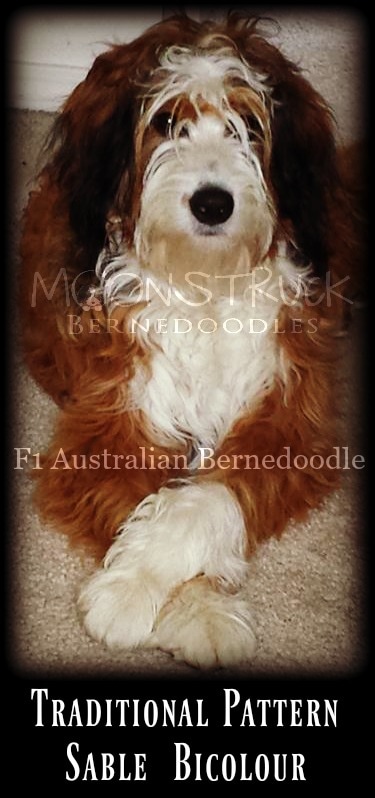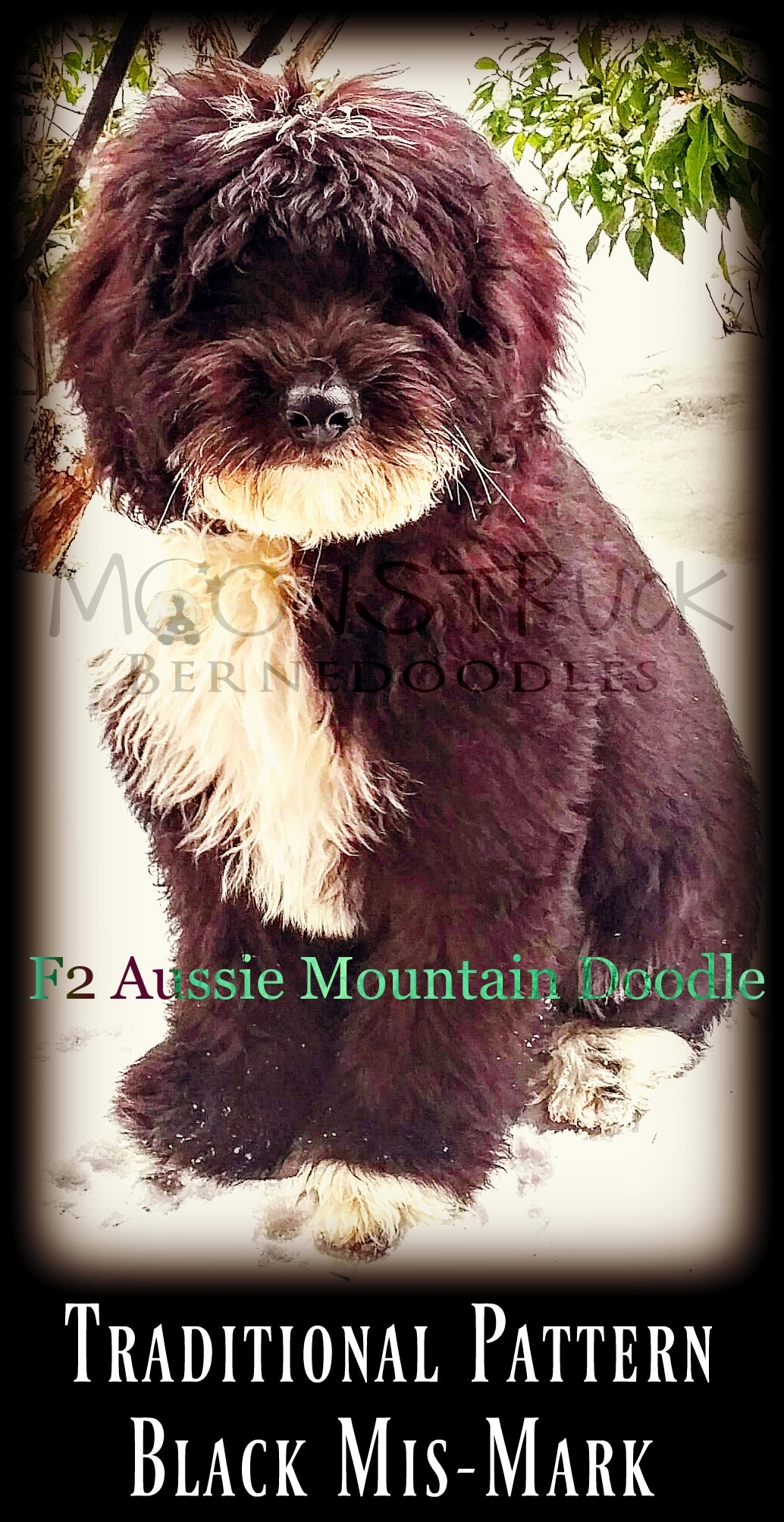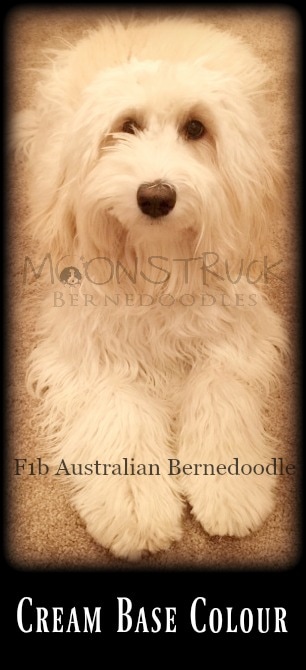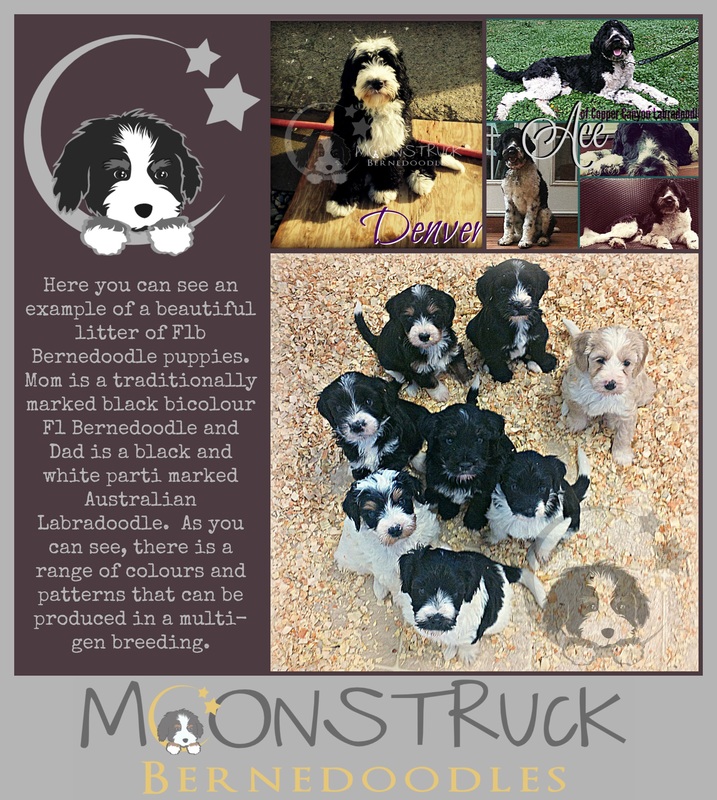Moonstruck Bernedoodles
Bernedoodles Explained
What is a Bernedoodle?
Bernedoodles (BD) are a relatively new cross between a Bernese Mountain Dog (BMD) and a Poodle (Usually Standard or Miniature Poodles are used).
OR
Bernedoodles can be a cross between a Bernese Mountain Dog (BMD) and an Australian Labradoodle (ALD) which some are calling Australian Bernedoodles (ABD). This helps immediately identify lineage from Poodle or Labradoodle.
OR
Bernedoodles can be a cross between a Bernese Mountain Dog (BMD) and an Australian Labradoodle (ALD) which some are calling Australian Bernedoodles (ABD). This helps immediately identify lineage from Poodle or Labradoodle.
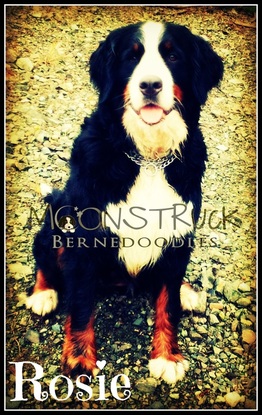
Bernese Mountain Dogs have wonderful temperaments. If you are unfamiliar with the breed, they are very Lab-like in their temperament traits: affectionate, silly, easily trained (they love food), they make wonderful companions for children as they are often very easy-going and patient. They were originally bred as a general farm dog, often used for droving and guarding cattle and for pulling carts loaded with goods. They are one of 4 types of Sennenhund-type dogs and originate in the Swiss Alps (the German name for Bernese Mountain dogs is Berner Sennenhund).

Australian Labradoodles are a relatively new breed that have now become quite established in the past decade and are easily recognized for their perpetual puppy look (if kept groomed properly!). Desirable temperament traits are very similar to the Bernese Mountain Dog: affectionate, intelligent, easy to manage family companions. The Australian Labradoodle is a multi-generational Labradoodle different than just a standard cross between a Lab and a Poodle. These dogs have been bred to be non-shedding, of medium size and ideally have a wavy and easy to manage/groom coat. These dogs are now "breeding true", which mean puppies are all very similar to each other and are similar to their parents. There are generally no surprises, although the odd one pops up here and there.
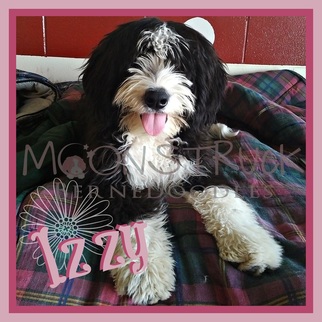
Outcrossing a Bernese Mountain Dog to an Australian Labradoodle gets you an Australian Bernedoodle (ABD) Australian Bernedoodles are the main focus of the Moonstruck Bernedoodle program. I feel that the temperaments and the structures of the BMD and the ALD are more suited to each other than that of a BMD/Poodle. There is nothing wrong with the Poodle crosses, and they can be quite lovely, but the consistency in coat-type and structure can be quite varied between puppies in the same litter. ALDs are bred to be stocky and square with heavier boning than Poodles. Because BMD are square stocky, heavy boned dogs they make a better physical match to an ALD. The ALD coats are wavy or straight (the ones that we use) which also gives us amazing low to non-shedding straight or wavy Australian Bernadoodle coats. Poodles have a very tight curl to their coat and this results in curlier coated Bernedoodles and a wider variety of coat-types in the litter. And finally, when it comes to head-type, the narrow head of the Poodle matched with the broad head of the BMD can sometime result in some abnormalities in skull structure (eye set slightly off, heads that seem too small for a stocky body), particularly in the bite. Under-bites and Base Narrow seem to be more common in the Poodle crosses (Lab/Poodles, Golden Retriever/Poodles, BMD/Poodles.... these are all broad headed dogs being matched to a dog that is not).
Learn Here About
Unfurnished Doodles!!!!
Moonstruck Bernedoodle Traits
*Family/Child friendly *Teddy bear cuteness!
*Low/Non-Shedding Coat *Easily Trained/Eager to Please
*Moderately Active *Intelligent and thoughtful
*Excruciatingly Loving *Health & Temperament Guarantee
*Low/Non-Shedding Coat *Easily Trained/Eager to Please
*Moderately Active *Intelligent and thoughtful
*Excruciatingly Loving *Health & Temperament Guarantee
Colours
*Click here to learn the science behind beredoodle colours!
The Moonstruck Bernedoodle lingo
The doodle lingo can be very confusing because there are all kinds of "generations" of doodles and various crosses that include more than one kind of cross. Generally speaking most breeders of Bernedoodles are referred to as "early gen" breeders. This means that they don't often go too far passed an F2 breeding as you start to loose the "look" that everyone loves about the Bernedoodle.
Moonstruck Bernedoodles focuses on HEALTH and TEMPERAMENT for wonderful, stable, trainable family pets... then we consider colours and coat-type.
Here's a quick breakdown of the Moonstruck Bernedoodle lingo you will find on this site (note: We do not use purebred Poodles in our program. This is a personal preference and does not reflect anything wrong with Poodles themselves. We prefer a more diluted Poodle temperament and a blockier structure of a Poodle cross than that of a pure Poodle.)
Doodle - Doodle is a broad term used to identify a Poodle cross of some type. The Prefix will denote the heritage of that doodle (i.e. Golden Doodle - Golden Retriever/Poodle)
F1 - This denotes a cross between a Bernese Mountain Dog and a Doodle. The tradidional"look" of the Bernese Mountain Dog (placement of the white) is dominant over the Poodle/Doodle colour genetics. F1 litters constantly produce that traditional look (if you have the parent's that will produce the colours you are looking for... that's a whole other complication!).
F1b- This denotes a cross back to a Doodle or a Bernese. This is generally done to a Doodle to improve coat quality but the result reduces the amount of Bernese in the dog.
F2 - This denotes a breeding between two F1 dogs OR an F1 and and F1b. Knowing the heritage of the dog will tell you how much Bernese is in the breeding.
F2b - This denotes a cross back to a Doodle OR it can denote a cross back to a Bernese. Technically if you cross back to a full Bernese the breeding would be considered an F1.
Multigen - once you pass F2 (depending on who you talk to) the dogs are considered Multigen. At this point you loose a lot of the classic Bernese "look" which is why most Bernedoodle breeders stick to early gen breedings.
Furnished - This is the "Doodle" look; puffy, fluffy everywhere!
Unfurnished - This is the doodle world's "dirty little secret!". Learn here about the Furnishing gene and how you can get all the benefits of a doodle with much less coat maintenance.
Bernedoodle - Describes a Bernese/Poodle.
Australian Bernedoodle - Describes an Bernese/Australian Labradoodle.
Australian Labradoodle - This is a multigeneration Labradoodle (can be 10+ generations) that is a blend of Labrador, Poodle, and Cocker Spaniel. This is not a "purebred" dog, however, they do have their own breed registry that keeps track of pedigrees and has a breeding standard. These dogs are very different from a simple Lab/Poodle cross. If you were to genetically test these dogs, most would come back as having a very heavy percentage of Poodle. This can be a bit misleading, because these dogs have been selectively bred over the generations to be different from Poodles, both in temperament and in structure. The Australian Labradoodle is essentially a genetically modified Poodle to fit a new roll as an easy going, attractive family pet.
American Labradoodle - This is a term that usually denotes early or multigen Lab/Poodle crossings that do not have Cocker Spaniel infused in the lineage. "American" in this case does not necessiarily denote a lineage of American Labrador bloodlines (Yes, there are two types of Labrador - English Show style and American Field style - each line is VERY different from each other. It's important to know these things!).
Golden Mountain Doodle - This is a mix of Golden Retriever, Bernese Mountain Dog and Poodle genetics. We do have litters like this from time to time.
Aussie Mountain Doodle - This is a mix of Australian Shepherd, Bernese Mountain Dog and Poodle genetics. We do have litters like this from time to time and it is a type of doodle that we are taking an interest in developing.
Moonstruck Bernedoodles focuses on HEALTH and TEMPERAMENT for wonderful, stable, trainable family pets... then we consider colours and coat-type.
Here's a quick breakdown of the Moonstruck Bernedoodle lingo you will find on this site (note: We do not use purebred Poodles in our program. This is a personal preference and does not reflect anything wrong with Poodles themselves. We prefer a more diluted Poodle temperament and a blockier structure of a Poodle cross than that of a pure Poodle.)
Doodle - Doodle is a broad term used to identify a Poodle cross of some type. The Prefix will denote the heritage of that doodle (i.e. Golden Doodle - Golden Retriever/Poodle)
F1 - This denotes a cross between a Bernese Mountain Dog and a Doodle. The tradidional"look" of the Bernese Mountain Dog (placement of the white) is dominant over the Poodle/Doodle colour genetics. F1 litters constantly produce that traditional look (if you have the parent's that will produce the colours you are looking for... that's a whole other complication!).
F1b- This denotes a cross back to a Doodle or a Bernese. This is generally done to a Doodle to improve coat quality but the result reduces the amount of Bernese in the dog.
F2 - This denotes a breeding between two F1 dogs OR an F1 and and F1b. Knowing the heritage of the dog will tell you how much Bernese is in the breeding.
F2b - This denotes a cross back to a Doodle OR it can denote a cross back to a Bernese. Technically if you cross back to a full Bernese the breeding would be considered an F1.
Multigen - once you pass F2 (depending on who you talk to) the dogs are considered Multigen. At this point you loose a lot of the classic Bernese "look" which is why most Bernedoodle breeders stick to early gen breedings.
Furnished - This is the "Doodle" look; puffy, fluffy everywhere!
Unfurnished - This is the doodle world's "dirty little secret!". Learn here about the Furnishing gene and how you can get all the benefits of a doodle with much less coat maintenance.
Bernedoodle - Describes a Bernese/Poodle.
Australian Bernedoodle - Describes an Bernese/Australian Labradoodle.
Australian Labradoodle - This is a multigeneration Labradoodle (can be 10+ generations) that is a blend of Labrador, Poodle, and Cocker Spaniel. This is not a "purebred" dog, however, they do have their own breed registry that keeps track of pedigrees and has a breeding standard. These dogs are very different from a simple Lab/Poodle cross. If you were to genetically test these dogs, most would come back as having a very heavy percentage of Poodle. This can be a bit misleading, because these dogs have been selectively bred over the generations to be different from Poodles, both in temperament and in structure. The Australian Labradoodle is essentially a genetically modified Poodle to fit a new roll as an easy going, attractive family pet.
American Labradoodle - This is a term that usually denotes early or multigen Lab/Poodle crossings that do not have Cocker Spaniel infused in the lineage. "American" in this case does not necessiarily denote a lineage of American Labrador bloodlines (Yes, there are two types of Labrador - English Show style and American Field style - each line is VERY different from each other. It's important to know these things!).
Golden Mountain Doodle - This is a mix of Golden Retriever, Bernese Mountain Dog and Poodle genetics. We do have litters like this from time to time.
Aussie Mountain Doodle - This is a mix of Australian Shepherd, Bernese Mountain Dog and Poodle genetics. We do have litters like this from time to time and it is a type of doodle that we are taking an interest in developing.
Well it's not a purebred Dog...
No, a Bernedoodle is not a "purebred" dog. A purebred dog is a dog that someone created because they like the characteristics of that dog and chose to make more of the same thing. Eventually it becomes a dog that "breeds true", meaning adults and puppies all look the same. Up until the start of the 20th century, breeds of dogs where constantly being crossed and manipulated to create useful working dogs or dogs that where just cute (Pugs really have no purpose, lol). With the invention of the Kennel Club and dog showing becoming so popular, the development of new breeds came to a virtual halt. What was in existence at that point got "locked in" so to speak because a registry of heritage was being kept. Through the 20th century we have seen almost no new breeds. Cross breeding became pooh-poohed, especially by the pure bred snobs and this suggestion filtered down into mainstream society. A purebred dog is "better". A dog is a dog, we shouldn't forget that.
Okay, but that's not the point I am trying to make. My point is this: Dogs are dogs. One is not better than the other, they are different. And at some point every "breed" had an origin and generally that origin came from crossing different breeds. The only reason there has not been much development of new dogs in the past 100 years or so it because it has been demonized by the purebred registries, The Kennel Club (UK), the Canadian Kennel Club, the American Kennel Club, and so on. The craze to own a purebred dog came from from the transition of dogs being used as working dogs - hunting, herding, guarding - to being house pets and "pictures of perfection" from "show champions". Functionality, in most cases, went flying out the window a long time ago. The vast majority of dogs today are people's pets - companions that need to be social and trustworthy in a very urban society.
What we are seeing today is a demand for a dog that is aesthetically pleasing (that teddy-bear look), easy to train for the average family, solid temperaments that are not naturally wary of strangers or particularly guardy/territorial, but tolerant and patient so they can be companions for children and easy-to-live-with family companions. Low to non-shedding has become popular in recent years, topping the attributes dog owners list as important to them in a dog. Let's face it, dog hair (as much as I love my shedding German Shepherds) is extremely annoying. It is left on furniture, on your bed, on your clothes, in your food. Shedding dog owners get used to eating it. After a while, you just don't even try to pick it out when you see it. Haha, no, seriously this is true!
What we are seeing today is a demand for a dog that is aesthetically pleasing (that teddy-bear look), easy to train for the average family, solid temperaments that are not naturally wary of strangers or particularly guardy/territorial, but tolerant and patient so they can be companions for children and easy-to-live-with family companions. Low to non-shedding has become popular in recent years, topping the attributes dog owners list as important to them in a dog. Let's face it, dog hair (as much as I love my shedding German Shepherds) is extremely annoying. It is left on furniture, on your bed, on your clothes, in your food. Shedding dog owners get used to eating it. After a while, you just don't even try to pick it out when you see it. Haha, no, seriously this is true!
|
Available Puppies The Moonstruck Difference
Purchase Contract Health & Temperament Guarantee Adoption Application Our Dogs Contact Us |
All content on this website © 2015 by Moonstruck Bernedoodles. All rights reserved. |
